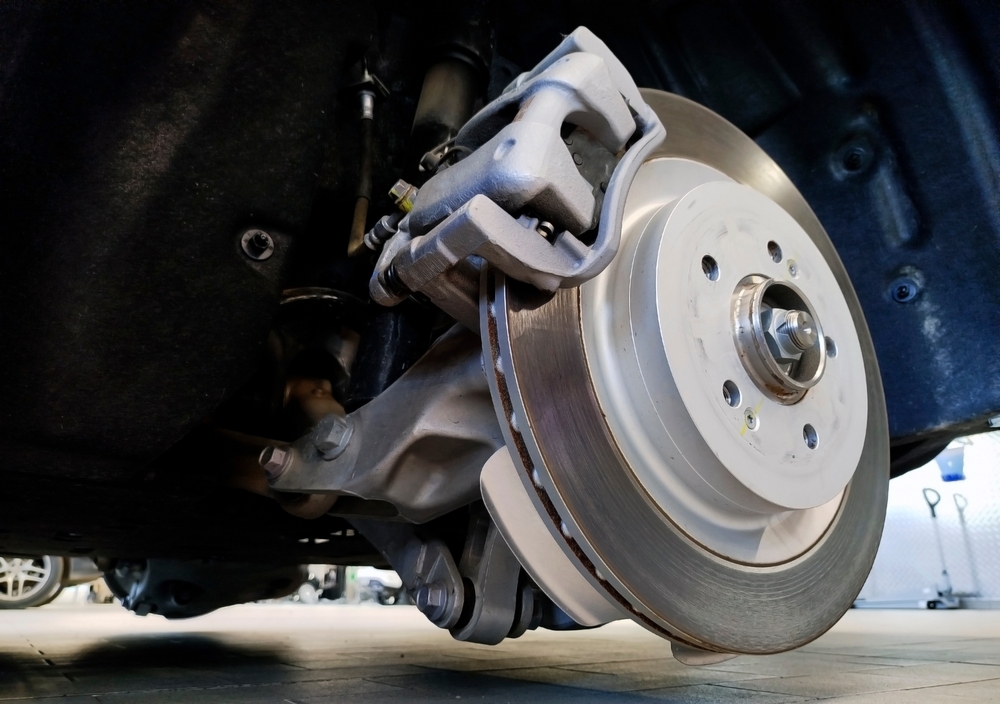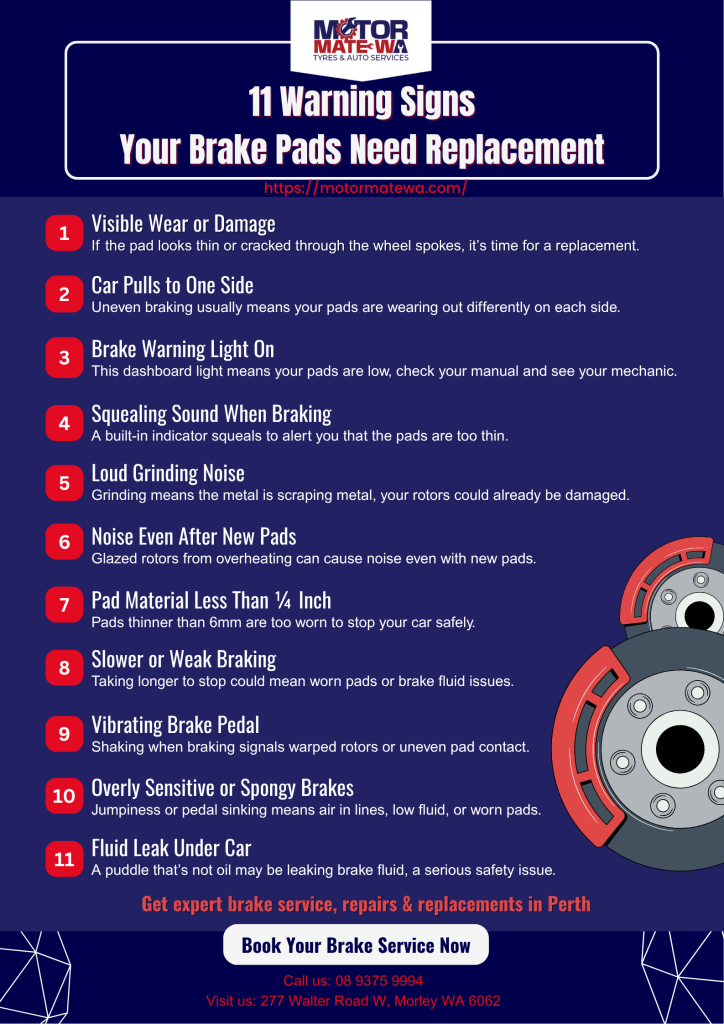Wondering When to Replace Brake Pads? | Explore 11 Signs, Repair Costs, & Pro Tips

Imagine you’re cruising through Perth’s busy streets, enjoying the drive. Suddenly you press the brake pedal, and something feels off. Maybe it’s a squealing noise, or the pedal feels spongy. Your heart skips a beat. Could your brake pads be failing?
As a driver, your car’s brakes are your lifeline. They keep you and your passengers safe. But how do you know when it’s time to replace brake pads? Ignoring the signs could lead to costly repairs or, worse, compromise your safety.
At Motor Mate WA, our Perth-based experts are here to guide you through everything about brake pad replacement, from warning signs to costs, lifespan, and how it all works. Suspect your car needs a brake replacement? Get a free quote online from our trusted mechanics today and drive with confidence.
Let’s explore why your auto brake pads matter and when to give them some TLC.
Understanding Brake Pads and Brake Shoes | How Do Your Car Brakes Work?
Your car’s brakes are its ultimate safety feature. And brake pads are the hardworking heroes behind every stop. Your car uses one of two braking systems, or sometimes both: disc brakes and drum brakes.
- Brake pads are found in disc brake systems. These pads sit inside a caliper that grips onto a spinning disc (also called a rotor). When you press the brake pedal, the caliper squeezes the auto brake pads against the disc, creating friction that slows the wheel down.
- On the other hand, brake shoes are part of drum brake systems. These are half-moon shaped parts that press against the inside of a spinning drum. You’ll usually find brake shoes on the rear wheels of many vehicles.
While both parts do the same job which is helping your car stop. But they work differently and wear out at different rates. For example, brake shoes generally last longer than brake pads due to their position and usage.
So, how do disc brakes and drum brakes work?
Most modern cars use disc brakes at the front and sometimes on all four wheels. Here’s how it works:
- Disc brakes use specially engineered brake pads made of materials like ceramic, metallic, or organic compounds. When you step on the pedal, these pads are pushed against the rotor (disc). This creates friction that slows your car down.
- Drum brakes, usually found on rear wheels, work a bit differently. Instead of pads, they use brake shoes with friction material on the outside. When the brakes are applied, these shoes push outward against the inside of a spinning drum. Thus, this creates the necessary stopping force.
No matter which system your car has, both brake pads and brake shoes wear down over time. And that’s where things can get risky if left unchecked.
What Happens If You Ignore Worn Brake Pads?
Each time you press the brakes, a tiny bit of friction material wears away. That’s totally normal. But over time, the material gets so thin that it can no longer do its job properly.
If you ignore the need for a brake pad replacement, the steel part of the brake pad (the backing plate) will start to grind directly on your disc or drum. This leads to longer braking distances and potentially dangerous driving conditions. Worst of all, it could damage the brake discs or drums, leading to much more expensive repairs.
That’s why it’s so important to check your brakes regularly and replace brake pads before they wear down too far.
So, how do you know if the brake pads need replacing? Look for these signs to know when to replace brake pads:
11 Warning Signs Your Brake Pads Need Replacement ASAP

Your car will let you know with any of these warning signs. If you spot any, don’t wait! Contact us for expert brake repair and drive safely.
1. You See Damage or Wear and Tear
One of the easiest ways to check your brake pad condition is with a quick visual inspection. Look through the wheel spokes. Can you see the pad pressed up against the rotor? If it looks thinner or damaged, it’s a good idea to have it checked out. Anything less than that could mean the pads are too worn and need replacing soon.
2. Your Car Pulls to One Side When Braking
If your vehicle pulls to the left or right when you press the brake pedal, it means the brake pads are wearing unevenly. This can cause unbalanced braking, which isn’t safe. It could also be a sign of contaminated brake fluid, which might need to be drained and replaced.
3. Brake Warning Light is On
Many newer vehicles are equipped with a dashboard brake pad warning light. If this light comes on, it means your brake pads are running low.
Be sure to check your owner’s manual to confirm whether your car has this feature. And remember: if the light is on, your mechanic may need to replace both the brake pads and the sensors.
4. High-Pitched Squealing When You Brake
Hear a loud squealing or screeching sound when you apply the brakes?
Don’t panic! It’s coming from a small metal indicator built into the brake pad. This noise is meant to warn you that your brake pads are getting thin and will soon need to be replaced. It’s your car’s way of saying, ‘time for a brake check!’.
5. Loud Grinding or Growling Sound
If you’ve ignored earlier squealing signs, the next stage might be a deep grinding noise. This means the brake pad material is completely gone. And now the metal backing plate is scraping against the rotor.
This can seriously damage your rotors and even cause the brakes to stick. Thus, creating a dangerous and expensive problem. If you hear this, get your car to a mechanic ASAP.
6. Screeching Even After Installing New Brake Pads
Still hearing odd noises even after replacing your brake pads? It could be a sign of glazed brake rotors. This happens when the metal heats up too much due to excessive braking.
Look for dark rings or blue marks on the rotors. If you see them, the rotors may be damaged and might need to be resurfaced or replaced.
7. Less Than a Quarter Inch of Brake Pad Material Left
If you have disc brakes, you might need to remove the wheel to check the actual pad thickness. If the friction material on the brake pad is less than ¼ inch (around 6–7 mm), it’s definitely time for an inspection. The thinner they get, the less effective your brakes become, especially in emergencies.
8. Braking Feels Slower or Less Responsive
Is your car taking longer to stop than it used to? That’s a major red flag. It might be due to worn brake pads, brake fluid leaks, or heat buildup from prolonged braking.
Overheating can cause your pads and rotors to lose grip. Thus, reducing their ability to stop the vehicle effectively.
9. Brake Pedal Vibrates
If your steering wheel or brake pedal shakes when you press the brakes, but stops vibrating when you let go, it’s time to check your braking system. The issue could be worn pads or warped rotors. These vibrations are usually caused by uneven contact between the pad and rotor.
10. Brakes Feel Too Sensitive or Insensitive
Brakes acting jumpy or overly touchy? It means the brake rotors are uneven. Or there’s too much pressure due to issues with your brake fluid. On the flip side, if your brakes feel spongy or require you to press the pedal nearly to the floor, that’s also a problem. It could mean:
- There’s air in the brake lines
- The brake fluid is too low
- The pads are excessively worn
- Or there’s a hydraulic system issue
In any case, get your brakes checked immediately.
11. Puddle Under the Car Could be a Brake Fluid
Noticed a small puddle under your parked car? If the fluid looks like motor oil but isn’t as greasy, it could be brake fluid. A brake fluid leak can drastically affect your car’s ability to stop. If you suspect a leak, have your car inspected right away. It’s a safety issue you don’t want to ignore.
Wondering how mechanics replace brake pads? Let’s get into it.
6 Easy Steps to Replace Brake Pads
Here’s a simple breakdown of what happens during a professional brake pad replacement. These steps ensure your car stops smoothly and safely every time.
1. Lift the Car and Remove the Wheels
The first step is to raise the vehicle using a jack or hoist. Once it’s safely lifted, the wheels are removed so the mechanic can access the brake components behind them.
2. Inspect the Brake Pads and Rotors
With everything exposed, the technician carefully checks the condition of the brake pads and rotors. If the pads are worn down or the rotors show signs of damage, they’ll be marked for replacement.
3. Examine the Brake Calipers
The brake calipers are then inspected to make sure they’re functioning correctly. These components press the pads against the rotors to stop the vehicle. So, they need to be in perfect working condition.
4. Fit the New Brake Pads
Next, the old brake pads are removed and replaced with brand-new ones. The technician ensures they’re fitted properly and securely so they operate safely.
5. Reinstall the Wheels
Once the new pads are in place, the wheels are reattached. And the car is lowered back to the ground.
6. Take a Road Test
Lastly, the vehicle is taken for a short road test. This allows the new brake pads to go through the ‘bedding in’ process. It ensures the braking system works as it should before handing it back to you.
How Much Does It Cost to Replace Brake Pads in Australia?
On average, the cost of brake pads replacement in Australia ranges from $300 to $600 per axle.
Several factors can push that price up or down. Like if you drive a high-end or performance car with larger, specialised brakes, costs can climb to $1,000 or more. These vehicles mostly require premium brake pads designed for extra stopping power.
Likewise, your front brake pads do about 70% of the work when stopping. So, they wear out faster and may need more frequent brake pad changes. Rear brakes, often drum brakes, tend to last longer but still need regular checks.
How Long Do Brake Pads Last?
Typically, brake pads last around 40,000 kilometres. But several factors can shorten or extend their life. Such as:
- Your Driving Style – City driving with frequent stops in Perth’s traffic can wear out brake pads faster than highway cruising. If you’re constantly braking, expect more frequent brake pad changes.
- Brake Pad Material – The type of brake pad matters. Ceramic auto brake pads last longer but cost more. Whereas, organic or semi-metallic pads can wear out sooner but are budget-friendly.
- Vehicle Type & Conditions – Heavier vehicles or those driven on hilly roads put more strain on brake pads, leading to quicker wear. Dusty or wet conditions can also reduce brake pad life.
How Long Should a Brake Service & Repair Take?
A basic brake service usually takes 1 to 2 hours, depending on what needs to be done. If the pads, rotors, or brake fluid need replacement, the time may vary slightly.
At Motor Mate WA, our expert technicians take the time to thoroughly inspect:
- Front and rear brake pads or shoes
- Disc and drum brakes
- Brake fluid levels and condition
- Calipers and wheel cylinders
We make sure every part of your brake system is safe, functional, and ready for the road. Whether it’s worn-out pads, leaking fluid, or warped discs, we handle it all with care and expertise. Before we hand your car back, we always do a final test drive to ensure your brakes are working exactly as they should.
Are your brakes trying to tell you something? Don’t wait for a grinding noise or light brakes to take action.
Contact Motor Mate WA | Book Your Brake Pad Replacement Today
At Motor Mate, our expert technicians provide expert brake repair and brake replacement using high-quality auto brake pads.
With transparent pricing, a nationwide warranty, and a commitment to your safety, we’re your trusted partner for all things brakes.
Whether it’s a brake pad change or a full brake service, we’ve got you covered.

